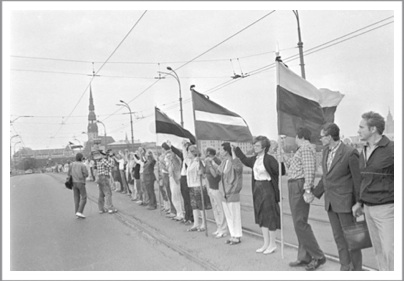
Linking arms for freedom
 The longest human chain in history was formed across the Baltics just twenty five years ago last week as a moral protest against the illegal occupation by the Soviet Union of these lands. It stretched from the north of Estonia across Latvia to the south of Lithuania.
The longest human chain in history was formed across the Baltics just twenty five years ago last week as a moral protest against the illegal occupation by the Soviet Union of these lands. It stretched from the north of Estonia across Latvia to the south of Lithuania.
In Riga a few days ago, where I was preparing for next year’s State of Europe Forum, Latvians who told me about events held last week to commemorate the human chain spoke with a new sense of urgency and anxiety.
Latvians have always felt betrayed, they told me, by Nazis and communists on the one hand, and by the west on the other. The big question for them today is how much the west is prepared to stand up against Putin’s expansionism.
For just 75 years ago, the infamous Molotov-Ribbentrop Pact was secretly signed on 23 August 1939, affecting the fate of millions of eastern Europeans. This pact divided eastern Europe into spheres of influence, leading directly to World War II and to the occupation of the three Baltic States–Estonia, Latvia and Lithuania.
Fifty years later, as one more expression of the rising tide of moral and spiritual protest against the totalitarism of the Soviet Union, some two million people joined their hands to form a continuous human chain stretching 600 kilometres across the three Baltic republics of the Soviet Union. One in every four persons participated in the chain, called the Baltic Way, holding hands for at least 15 minutes. The public protest demanded acknowledgment of the Molotov-Ribbentrop pact, the existence of which was still denied by Soviet officals who continued to assert that the Baltic states had voluntarily joined the USSR.
The massive turnout for the silent protest was a powerful moral and emotional demand for the re-establishment of the independence of the Baltic states.
Seven months later, Lithuania became the first Soviet Union republic to declare independence. Latvia gained her freedom in 1990; Estonia in 1991.
Violations
Actually the event’s beginnings were in Canada where refugee communities from central and eastern Europe initiated Black Ribbon Day on 23 August 1986. The aim was to draw global attention to Soviet crimes and human rights violations, to the Molotov-Ribbentrop Pact as well as to the Yalta Conference when Churchill and Roosevelt gave Stalin a free hand to annex states occupied by the Soviet Union. The first Black Ribbon Day saw demonstrations in many western cities including London, Stockholm, Washington DC, New York, and Perth, Australia.
As glasnost and perestroika stimulated a new openness and rising hope of freedom in the communist world towards the end of the 1980’s, several Baltic pro-independence movements–Rahvarinne of Estonia, the Tautas fronte of Latvia, and Sąjūdis of Lithuania–met discretely to plan the 1989 protest. In Tallinn, capital of Estonia, demonstrators in a public park spoke openly of the Molotov-Ribbentrop Pact with the KGB observing. Names were taken, leaders were harassed, but surprisingly, no one was arrested.
The organisers were emboldened to call for a massive, public, non-violence symbolic act, a human chain of solidarity among the three nations.
Awakening
While the Baltic Way was the largest and most important campaign of the Baltic states aimed towards regaining their freedom, it was not the first. The Freedom Monument in the centre of Riga had been the focus of the Remembrance Day commemoration for the Victims of the 1941 Deportations on 14 June 1986. After that the former political prisoners from the Baltic states agreed upon a joint remembrance campaign on the 23 August in all the Baltic states.
On that date in 1987, several thousand people demonstrated in Vilnius, Riga and Tallinn. Police detained several hundred people. The following year, tens of thousands took part in the remembrance campaigns; while in 1989 a full quarter of the population participated in the human chain campaign. The Baltic Awakening was grown into a movement uniting all three countries.
This display of ‘soft power’ forced the once-powerful Soviet Union to yield to the voice of the people and admit the crimes of the past, including the existence of the Molotov-Ribbentrop pact.
In 2009, the European Union recognised August 23 as the European Day of Remembrance for Victims of Stalinism and Nazism. That date this year probably passed unnoticed. We were distracted by reports of thousands of Russian troops ‘on vacation’ across their border.
Current events will test us as to how well we remember this history and how well we have learned our lessons from the past. Will the west link arms with the Baltics?
Till next week,
Jeff Fountain

This Post Has 0 Comments